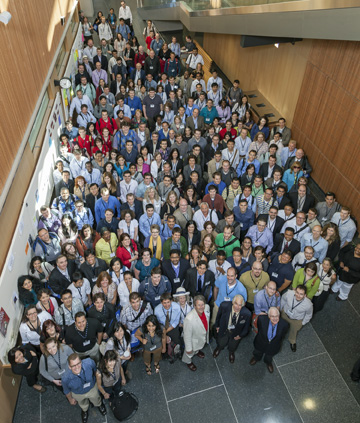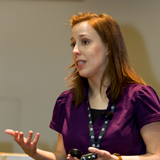Grants and Funding: Extramural Programs (EP)


2012 NLM Training Conference Participants
NLM Informatics Training Conference 2012
National Library of Medicine and the
University of Wisconsin
Madison, WI
June 26–27, 2012
The 2012 NLM Informatics Training Conference was hosted by the University of Wisconsin on June 26-27, 2012 in Madison, Wisconsin. Conference attendees included trainees and faculty from the NLM Biomedical Informatics Research Training Programs, VA informatics trainees, NLM intramural trainees, NIH staff, and guests.
- Agenda and Abstracts (PDF 583KB)
- Photo Gallery
- Conference Awards
NLM 2012 Informatics Training Conference Awards
Best Presentation
June 26, 2012
Krystl Haerian
Columbia University
Pharmacovigilance and Drug Repurposing Model and Application: A Case Study
Plenary Paper Session 1
Abstract:
An important component of drug safety, pharmacovigilance, entails detecting the risk of unknown serious adverse drug reactions. The primary goal of our study was to use the information in free text EHRs to develop a model for drug induced valvular heart disease (VHD) that can translate retrospective health data into knowledge. Our VHD model was based on 123,177 inpatients. We used natural language processing to obtain information from discharge summaries and linear regression to control for potential confounders. The model was applied to screen known drugs, published drug suspects (identified though binding assays and quantitative structure-activity relationship (QSAR) models), and other drugs of interest. Our model identified a positive signal with the known valvulopathogens, fenfluamine and pergolide. We also found that two atypical antipsychotic medications resulted in a lower than expected prevalence of VHD. NLP and statistical modeling of EHR data is useful for pharmacovigilance studies. Furthermore, existing EHR data can be utilized to perform translational studies, examining molecular based theories in observational databases. In addition, the unexpected finding of drugs that lowered the risk of VHD has preliminary implications that the EHR may also be a valuable source of information for drug repurposing studies. Characterization of the repertoire in humans, as well as model systems. Analyzing these data presents several challenges. Here we describe our efforts to: (1) develop an automated analysis pipeline that is robust to the high error rates associated with NGS data, (2) identify somatic mutations and separate sequences into clonally-related groups, (3) quantify selection and analyze mutation properties. We demonstrate our approach using human NGS data collected from three individuals at various times following influenza vaccination.

Krystl Haerian
June 27, 2012 (Tie)
Christine B. Peterson
Rice University
Building Inferring Metabolic Networks Using the Bayesian Graphical Lasso
Plenary Paper Session 3
Abstract:
Chronic neuroinflammation is a hallmark of many neurodegenerative diseases such as Alzheimer’s and Huntington’s. Despite its significance, the mechanisms by which neuroinflammation leads to disruptions in cellular function are not well understood. One of the less explored cellular functions affected by neuroinflammation is metabolism. Metabolic changes underlying neuroinflammation can be exploited for biomarker discoveries and future drug developments. To understand these changes, we have developed statistical methods that allow inference of the cellular metabolic networks from a set of critical metabolites identified and quantified in inflamed cells. Our approach builds on the Bayesian graphical lasso, a technique for learning a sparse graph structure from the covariance of the data. To encourage edges between metabolites with known relationships, we allow each entry in the precision matrix to have a unique shrinkage parameter with a gamma prior shifted towards zero for molecules closer together in a reference network. By incorporating informative priors, we improve the reliability of network inference given the small sample sizes and high degree of noise. The resulting identification of cellular reactions under neuroinflammatory conditions not only increases scientific understanding of the mechanisms of neuroinflammatory diseases, but also provides potential targets for future treatments. This project is supported in part by a training fellowship from the Keck Center NLM Training Program in Biomedical Informatics of the Gulf Coast Consortia (NLM Grant No. T15LM007093).

Christine B. Peterson
June 27, 2012 (Tie)
Timothy D. Imler
Regenstrief Institute
Building the Next Generation of Medical Education: Case Based Online Interactive Learning from Drawing Board to the Conference Room
Plenary Paper Session 4
Abstract:
Medical education has remained unchanged since the “modern” movement began with Osler. With information for practicing medicine increasing at an exponential rate the manner education is imparted to all levels of learners must be readdressed. Education time has also been getting compressed with increasing work hour restrictions and shift towards service requirements. In 2008 FromtheCaseFiles.com was designed by the authors at a single teaching institution to provide case based medical education to resident physicians. Multiple iterations of the system have languished without a structured mechanism for expansion with more than 380 physicians with 575 cases. Research on the tool has yielded significance (p < 0.005) in regards to allowing more information to be presented in a shorter period. The submission for publications also increased in a group of residents using the system for 9 months. A major redesign of the structure is currently underway. The emphasis is on improving mobile interaction during group presentations. Online and interactive case based medical education is an important tool moving forward. The lessons learned in early construction of the tool have been instrumental in the redesign process and ongoing research will help to assess the impact that can be made.

Timothy D. Imler
Best Poster
June 26, 2012
Daniel Gadala-Maria
Yale University
Pipeline for Analysis of Immunoglobulin Sequences on the Repertoire Scale
Poster Session Topic 3 – Translational and Bioinformatics
Abstract:
During an immune response, B cells encoding immunoglobulin (Ig) able to bind antigen are selected to expand clonally and undergo subsequent rounds of somatic mutation and selection. An individual’s Ig repertoire can be represented by the millions of unique Ig sequences that result from this process, as well as the relative proportions of these sequences. Next-generation sequencing (NGS) now allows for large-scale characterization of the repertoire in humans, as well as model systems. Analyzing these data presents several challenges. Here we describe our efforts to: (1) develop an automated analysis pipeline that is robust to the high error rates associated with NGS data, (2) identify somatic mutations and separate sequences into clonally-related groups, (3) quantify selection and analyze mutation properties. We demonstrate our approach using human NGS data collected from three individuals at various times following influenza vaccination.

Daniel Gadala-Maria
June 27, 2012 (Tie)
Perry Evans
Yale University
Evaluating Melanoma Whole Exome Sequences Suggests New Driver Genes
Poster Session Topic 2 – Bioinformatics
Abstract:
The identification of mutations in receptor and non-receptor protein kinases that drive malignant transformation of cells into melanoma, the most deadly form of skin cancer, has revolutionized the care of patients by providing patient-tailored targeted therapies that improve survival. The most promising example is the activating V600E/K mutation in the protein kinase BRAF. This mutation is present in ~50% of cutaneous melanomas, and drugs have been developed to inhibit this mutant kinase. There is a great interest in identifying additional ‘drivers’ that contribute to melanoma pathogenesis because large numbers of patients do not have BRAF mutations, and melanomas with BRAF mutations tend to develop resistance to the inhibitors with time. In this study, we propose additional driver genes by examining the mutational landscape of melanoma determined by sequencing the exomes of 148 tumors. We develop models of background silent mutation rates across the exome that account for gene expression, tumor type, and sequence context. Using our background silent mutation rates, we identify genes with a significant amount of nonsynonymous mutations across the 148 tumors. Our study successfully identifies known driver genes like BRAF and NRAS, and suggests important new drivers.

Perry Evans
Best Open Mic
June 26, 2012
Rimma Pivovarov
Columbia University
Prediction of Kidney Disease Outcomes Using Structured and Narrative Longitudinal Data

Rimma Pivovarov
